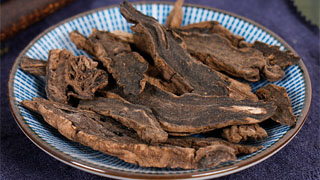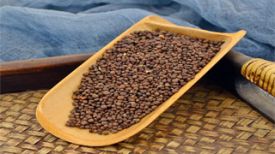
1. Aliases
Yuanshen, Beixuan Shen, Heishen, Shandanggui, Chongtai, Xuantai, Zhuma.2. Plant morphology
Perennial herbaceous plant, with a height of 60-120 centimeters. The root is plump, cylindrical, often branched below, and the outer skin is grayish brown. The stem is upright, square in shape, with grooves. The lower leaves are opposite, while the upper leaves are sometimes alternate, both with stalks. The leaves are ovate to long ovate, 5-12 cm long and 3.5-12 cm wide, with a pointed apex, rounded or nearly truncate base, and serrate edges.
The total inflorescence of a cyme is compressed into a spike shape, with glandular hairs on both the inflorescence axis and peduncle. The calyx is 2-3 millimeters long, 5-lobed and almost reaching the base. The lobes are nearly circular, with membranous edges. The corolla is yellow green in color, and the tube is inclined to a pot shape. It can produce 4 stamens and 1 degenerated stamen, which is nearly circular. It is attached to the corolla tube, and the ovary is superior, with 2 chambers. Capsule ovoid, approximately 6 millimeters long.
3. Origin distribution
Likes to grow in moist soil. Distributed in Heilongjiang, Jilin, Liaoning, Hebei, Inner Mongolia and other places.
4. Harvesting and processing
Dig out the roots from October to November, remove the stems, leaves, and soil, peel off the seed buds for cultivation purposes. When the roots are sun dried and the internal color turns black, cut off the reed heads and fibrous roots, store them for 3-4 days (sweating), and then sun dry or dry them.
5. Characteristics of medicinal herbs
Cylindrical, slightly thicker in the middle or slightly thicker in the top and thinner in the bottom, some slightly curved like sheep horns, 6 to 20 centimeters long and 1 to 3 centimeters wide. The surface is grayish brown, with longitudinal wrinkles, fine roots, and fine root marks. Solid in texture, difficult to break, slightly flat in cross-section, black in color, slightly glossy. It has caramel gas, a sweet and slightly bitter taste, and is soaked in water, which turns black. It is better to have thick, solid texture, and black cross-section.
6. Nature, taste, and meridian tropism
Mildly cold in nature, with a sweet, bitter, and salty taste. Return to the lung meridian, stomach meridian, and kidney meridian.
7. Effect and function
Cooling blood, nourishing yin, purging fire, and detoxifying. A heat clearing and blood cooling medicine classified under the category of heat clearing medicine.
8. Clinical applications
Dosage 9-15 grams, take decoction or pill powder internally to treat heat and yin injury, tongue depression and thirst, warm and toxic hair spots, Tianjin injury and constipation, bone steaming and fatigue, redness of the eyes, sore throat, scrofula, diphtheria, abscess and sore toxin, and hypertension. Apply externally by tamping or grinding and adjusting. Treatment for sore throat and tongue: 15 grams of Xuanshen, Shegan, and Huangyao each, decoction in water.
9. Pharmacological research
Xuanshen water immersion, alcohol infusion, or injection into normal (cats, dogs, rabbits) and renal hypertensive dogs have a hypotensive effect. Alcohol extract can also resist hypoxia, myocardial ischemia, and increase myocardial blood volume; The aqueous extract has a significant relaxing effect on the isolated guinea pig bronchi and can enhance the action of adrenaline.
Toxicity: The LD50 of the water decoction injected into the abdominal cavity of mice is 15.99~19.91 g/kg. It also has antipyretic, antibacterial, protective effects against myocardial ischemia, spasmolysis, blood pressure lowering, and blood glucose lowering effects.
10. Chemical composition
The root contains gabalin (70%~80%), 8-o-methylp-coumarin, and gabalin, all of which are substances that turn black. In addition, it contains Habaooside, Sophora triterpenoides, Sophora seed glycosides, Peach leaf coral glycosides, Sophora cycloethers, Jingnipin glycosides, Saistanide F, Decaffeoyl piloside, Piloside, etc.
11. Taboos for use
Those with spleen deficiency, loose stools, or dampness in the spleen and stomach should not take it. Not suitable for use with quinoa.
12. Compatibility prescription
① Treat mouth and tongue sores that do not heal for a long time: 30g each of Xuanshen, Tianmendong (heart removed, roasted), and Maimendong (heart removed, roasted). Crush Luo into powder, refine honey and pills, as big as a ball. Wrap one pill with cotton to dissolve throat fluid. (Xuanshen Pill in the "Shengji Zonglu")
② To treat nasal ulcers: use black ginseng, water stains to soften, stuff in the nose, or use it as a final cleanser. (Hygiene Simplified Formula)
③ Treating thirst and dry throat while lying down at night: Take two pieces of Xuanshen in your mouth, which produces body fluids. (Ji Ren Ji Yan Fang)
④ To treat qi deficiency and blood stasis, red and turbid urine, as if blood is not blood, as if drowning is not drowning, and pain in the drowning tube: 30 grams each of Xuanshen and Cheqianzi, decoction in water. (Xuan Che Dan from "Dialectical Records")
⑤ Due to the deviation of yin and yang, there is excess fire but insufficient water. When encountering problems or talking too much, it can cause annoyance and often cause disturbance in the chest. The sound is varied and noisy: 60 grams each of Xuanshen and Maidong, boiled in water. (Xuandong Tang from "Dialectical Records")
The content of the article is for clinical reference only. Non professionals in traditional Chinese medicine are not allowed to try medication.


